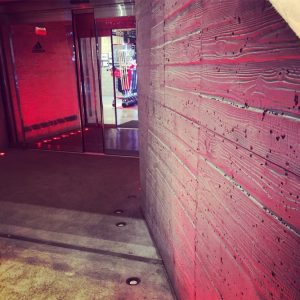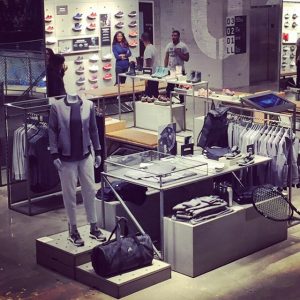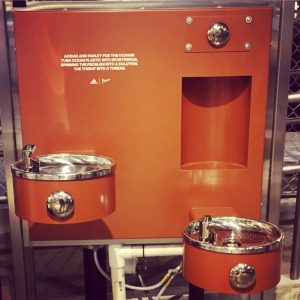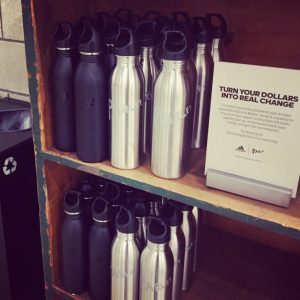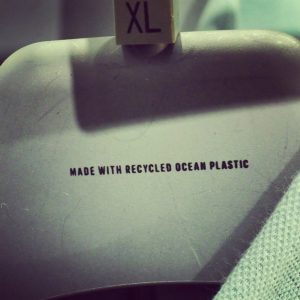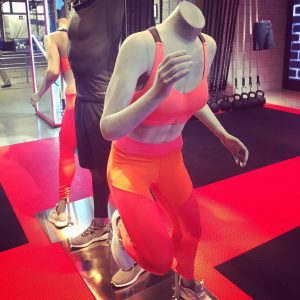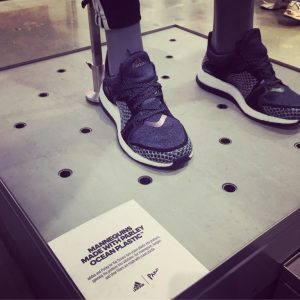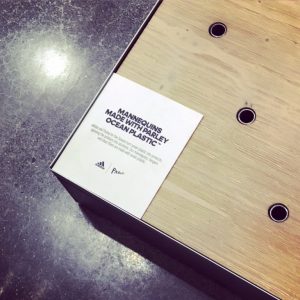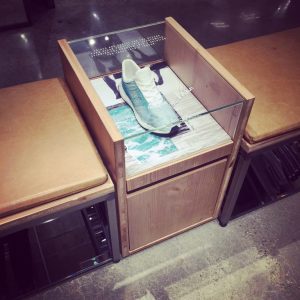Adidas and its massive concrete greeting column, adorned with its illuminated logo, make a grand entrance on New York’s Fifth Avenue. Large, angled concrete walls, mimicking stadium tunnels, and highlighted with red light, slice through the two-story curtain glass storefront to create the store’s main entry. From entry throughout the entire store, the vibrancy of the products and the graphic elements pop against the overall stark gray concrete and metal space, the main materials composing the cool urban ambience. Even the featured lighting is designed in a neon style to create energy, popping and reflecting off the concrete. From products to brand experience, adidas’ new flagship store unveils their latest in design and innovation, striving to connect to their customer in a whole new way.
Photography: Rebekah L. Matheny, Columbus, Ohio
The store’s concept is designed to create a new experience for customers, featuring areas like “the turf” and “the field,” which allow people to connect to the products through test areas. Connecting to “digital natives,” in-store technology also plays a major role within the retail space. Using virtual reality, customers can interact with NBA players as they tell the story of their signature sneakers. Further telling the adidas story, digital touchscreens provide customers with 3-D views displaying the various features of the shoe’s design, keeping costumers engaged at every turn. For the very first time for adidas, customers can even use a kiosk to create their own custom running shoe, and what millennial doesn’t want to stand out in the crowd with a pair of sneakers like no one else?!
Though more subtle, there’s another approach in which the store’s design connects to customers: Sustainable storytelling elements that, on first walk though may even go unnoticed, speak to the brand’s long history with environmental stewardship. For the right consumer – think millennials and Gen Z’ers who aren’t just digital natives, but who are also driven by generosity and environmental sustainability – these elements may leave an even more impactful and lasting impression, and forge an even stronger connection to the brand and its products.
Photography: Rebekah L. Matheny, Columbus, Ohio
However, I recently asked a student visiting New York to go look for these sustainable storytelling elements, and she had a very difficult time finding them. When she asked an employee, he pointed to the water fountain and a water bottle display, and said to check out the mannequins. Hidden in small text on the hangers or located on a plaque below some of the mannequins, adidas communicates their collaboration with Parley for the Ocean to turn ocean plastic into their charcoal gray product displays. The water fountain/bottle refill station has a small screenprint that repeats this message. Its water bottle display has a similar message, going a bit further to speak to their donations to the Parlay Ocean school program, supporting cleanups and the Parlay Air initiative. A customer may also happen to sit down on a bench, which contains a transparent display case where the message is repeated. Inside sits a white and turquoise limited-edition eco-shoe, designed and launched earlier in the year. This innovative shoe was created with ocean plastic, recycled into thread to form 95 percent of the shoes’ upper, the remaining 5 percent from recycled polyester.
Advertisement
Photography: Rebekah L. Matheny, Columbus, Ohio
EcoWatch relays that every year enough plastic is thrown away to circle the globe four times. And most of the rubbish ends up in the oceans, where it swirls around in great convergences, breaks down into smaller particles, and oftentimes poisons wild animals.
Erik Liedtke, the group executive board member for adidas, said in a statement: “This represents another step on the journey of adidas and Parley for the Oceans; we have not only managed to make footwear from recycled ocean plastic, but have also created the first jersey coming 100 percent out of the ocean. But we won’t stop there. We will make one million pairs of shoes using Parley Ocean Plastic in 2017 – and our ultimate ambition is to eliminate virgin plastic from our supply chain.”
But this complete story of how and why these harmful ocean plastics are captured and transformed into material product innovations is missing within the store environment. Inspired by this initiative, and curious about how this is accomplished, I personally want the process to be illustrated within the store environment. Instead, I had to go search the Internet and the company’s website to find out more about what they are doing to protect the environment.
If you dig through their website, you can uncover some amazing facts about adidas’ sustainable mission. In their sustainable history section they state, “We have been working toward sustainability for many years and recognize that the task ahead of us is a marathon, not a sprint. Whether it is about global supply chain management, environmental footprint, or community programs, the adidas Group has been running leadership programs for years.”
In fact, adidas has been working toward these goals since 1989, establishing standards and policies in 1998 for their manufacturing process and facilities and workplaces, becoming the first in the industry to receive EMAS, or Environmental Management System certification. In 2001, they took a step toward transparency, releasing their sustainability reports to the public, and going even further in 2007 to release their supplier factory list. Ever since, they have been making leaps toward environmental and social sustainability, and in 2015, they were ranked among the top three of the most sustainable companies worldwide (Global 100 Index). That’s certainly something to be celebrated and an element that could resonate with a lot of consumers.
Advertisement
With such a rich history, why doesn’t it appear in the store’s experience and brand messaging? With all of this effort from the company to improve the planet, why doesn’t the retail environment make a stronger connection between people, its products with a purpose and its message of protecting the environment?
We know from research that customers are “speaking” with their purchases and becoming more loyal to brands that share their values. However, few retailers, including the latest adidas store, are truly capturing these ideals of responsible consumption, and products with a purpose, within their retail environments and product merchandising.
As we look to the future of retail design, where retailers strive to make a more meaningful connection with their customers, how can store designs utilize sustainable storytelling to better inform and educate consumers towards environmental and social good?
Rebekah L. Matheny is the assistant professor of interior design at The Ohio State University (Columbus, Ohio), where she teaches courses in interior finish materials, lighting design and design studios that integrate a retail brand strategy process. Matheny’s research investigates the sensory perception of interior finish materials and their application in retail design to create an emotional connection between the customer and the brand. Follow Rebekah and her journey with materials on Instagram @rebekahmathenydesign and to start a dialogue about the sensory experience of materials visit her web site interiormaterialsmatter.com.


 Photo Gallery1 week ago
Photo Gallery1 week ago
 Headlines1 week ago
Headlines1 week ago
 Headlines2 days ago
Headlines2 days ago
 Headlines1 week ago
Headlines1 week ago
 Headlines1 week ago
Headlines1 week ago
 Designer Dozen2 weeks ago
Designer Dozen2 weeks ago
 Designer Dozen6 days ago
Designer Dozen6 days ago
 Headlines1 week ago
Headlines1 week ago


